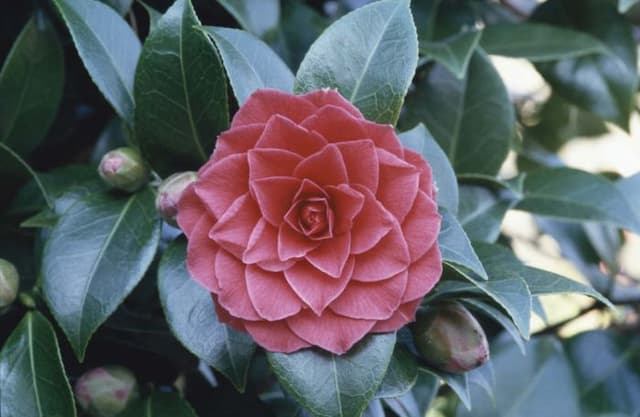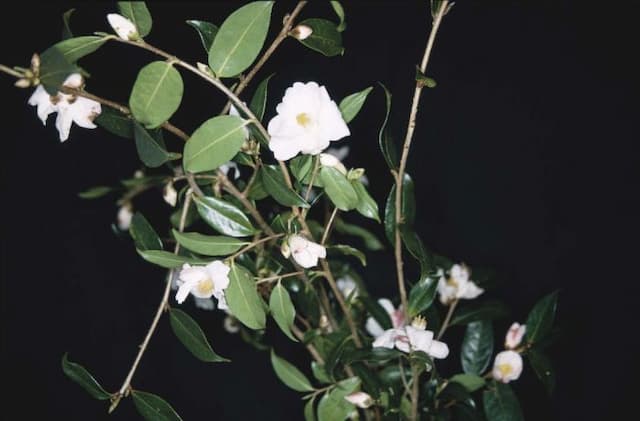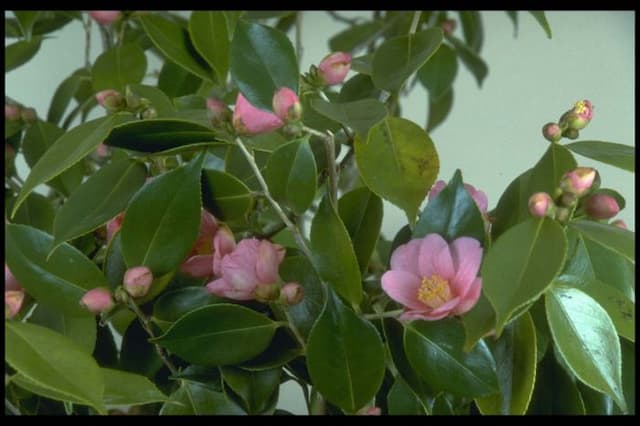Japanese Camellia Camellia japonica 'Black Magic'

ABOUT
Camellia japonica 'Black Magic' is acclaimed for its unique and strikingly dark, almost black flowers. These blooms are large and have a classic, rose-like form with layers of petal that give them a luxuriant, full appearance. The flowers stand out due to their deeper color, which contrasts with the glossy, dark green foliage. Each petal has a velvety texture and together they form a perfect, symmetrical flower. The leaves themselves are broad, oval-shaped, and have a smooth, leathery surface. As the blooms unfurl, you may notice the subtle hints of red at the edges, which gives the floral display an added depth and complexity. The overall effect is that of an elegant and sophisticated plant that provides a dramatic point of interest in any garden setting where it is placed.
About this plant
 Names
NamesFamily
Theaceae.
Synonyms
Japanese Camellia, Common Camellia, Camellia.
Common names
Camellia japonica 'Black Magic'.
 Toxicity
ToxicityTo humans
The common name for Camellia japonica 'Black Magic' is Japanese camellia. Japanese camellia is not considered toxic to humans. Therefore, ingesting parts of this plant is not expected to cause poisoning or adverse health effects. However, as with any plant material, individual allergies and reactions can occur, so it is always best to exercise caution and keep plants out of reach of small children who might ingest them out of curiosity.
To pets
The common name for Camellia japonica 'Black Magic' is Japanese camellia. Japanese camellia is generally considered non-toxic to pets. This means that ingestion of the plant should not cause poisoning or serious health issues in pets such as dogs and cats. However, consuming plant material can sometimes lead to mild gastrointestinal upset in some pets, so it is still advisable to prevent your pets from eating this plant.
 Characteristics
CharacteristicsLife cycle
Perennials
Foliage type
Evergreen
Color of leaves
Green
Flower color
Red
Height
6-10 feet (1.8-3 meters)
Spread
5-8 feet (1.5-2.4 meters)
Plant type
Shrub
Hardiness zones
7
Native area
Japan
Benefits
 General Benefits
General Benefits- Aesthetic Appeal: Camellia japonica 'Black Magic' has beautiful, dark red to almost black flowers that add a dramatic touch to any garden.
- Year-Round Interest: This plant offers glossy, evergreen foliage, which provides visual interest even when it's not in bloom.
- Privacy Screen: Due to its dense growth habit, it can be used as a privacy hedge or screen in landscapes.
- Wildlife Habitat: Provides food and shelter for birds and beneficial insects, such as pollinators.
- Low Maintenance: Once established, it requires minimal care, making it suitable for various gardeners’ experience levels.
- Versatility: Can be used in many landscape applications, including as a specimen plant, in foundation plantings, or in mixed borders.
- Long Blooming: It boasts a long blooming season compared to other plants, extending the color display in the garden.
- Winter Blooming: Flowers during the late winter and early spring when few other plants are in bloom.
- Soil Adaptability: Adaptable to a variety of soil types, though it prefers acidic, well-drained soils.
- Cultural Significance: Often associated with elegance and is a traditional plant in many Eastern cultures, adding cultural depth to gardens.
 Medical Properties
Medical PropertiesThis plant is not used for medical purposes.
 Air-purifying Qualities
Air-purifying QualitiesThis plant is not specifically known for air purifying qualities.
 Other Uses
Other Uses- Ink and Dyes: The petals of Camellia japonica 'Black Magic' can be used to create natural dyes or inks for art projects, due to their deep coloration.
- Crafts: Dried petals can be incorporated into homemade paper or potpourri, adding a unique texture and color.
- Photography: The striking flowers serve as an excellent subject for botanical photography, offering vibrant contrast and rich hues.
- Flower Arranging: Both fresh and dried flowers can be used in floral arrangements to add a touch of elegance.
- Wedding Decor: The 'Black Magic' blooms are popular in wedding bouquets and decorations for their romantic, deep color.
- Culinary Presentation: Although not edible, the petals can be used as a decorative garnish on sophisticated dishes and desserts.
- Textile Coloring: Historically, the petals may have been used to tint fabrics and yarns with subtle hues.
- Garden Accent: The dark foliage and flowers offer a dramatic backdrop in light-themed gardens to create visual pop.
- Educational Tool: Used in botany and horticulture education to demonstrate the variety of camellia cultivars.
- Perfumery: While not a traditional use, breeders may explore the extraction of scents from 'Black Magic' for use in perfumery.
Interesting Facts
 Feng Shui
Feng ShuiThe Camellia is not used in Feng Shui practice.
 Zodiac Sign Compitability
Zodiac Sign CompitabilityThe Camellia is not used in astrology practice.
 Plant Symbolism
Plant Symbolism- Adoration: Camellia japonica 'Black Magic', commonly known as the Japanese camellia, often symbolizes deep and longing adoration due to its lush, full blossoms which are associated with the allure of romantic love.
- Perfection: With its perfectly formed petals, the Japanese camellia signifies the quest for excellence and flawless beauty.
- Longevity: The camellia's ability to flower for long periods, and in many climates, makes it a symbol of longevity and enduring reliability.
- Love: The rich, deep color of the 'Black Magic' variety can be associated with the intensity of passionate love.
- Affection: Giving a camellia is a way to express affection towards someone, indicating the giver’s genuine fondness for the receiver.
 Water
WaterJapanese Camellia, commonly known as 'Black Magic', should be watered thoroughly to keep the soil evenly moist but not saturated. You may need to water the plant once a week, depending on climate conditions, but always check the top inch of soil for dryness before watering. During the growing season, especially in dry or hot weather, increase watering frequency. Provide about 1 gallon of water per watering for a medium-sized plant but adjust the amount based on the plant's size and environmental factors. Cut back on watering during the winter months when the plant is not growing actively.
 Light
LightJapanese Camellia 'Black Magic' thrives in partial shade with filtered sunlight. The ideal spot is one where it receives morning light but is protected from the intense afternoon sun, which can cause leaf scorch. Avoid deep shade as it can lead to poor flowering; dappled light under a high canopy is preferred.
 Temperature
TemperatureJapanese Camellia 'Black Magic' prefers temperate conditions and can handle short periods of temperatures as low as 20 degrees Fahrenheit, but prolonged exposure can be damaging. The ideal temperature range for this camellia is between 60 to 80 degrees Fahrenheit. Ensure the plant is protected from freezing temperatures and strong winds, which can harm the buds and flowers.
 Pruning
PruningPrune Japanese Camellia 'Black Magic' after it finishes blooming, typically in late winter or early spring, to maintain its shape and remove any dead or weak branches. Pruning encourages healthy growth and air circulation. Annual light pruning is sufficient, but for more substantial shaping or to control size, do so immediately after flowering as next year's buds form during summer.
 Cleaning
CleaningAs needed
 Soil
SoilThe Japanese Camellia 'Black Magic' thrives in well-draining, acidic soil with a pH range of 5.5 to 6.5. A soil mix composed of equal parts peat moss, leaf mold, and pine bark or well-rotted compost is ideal, providing both acidity and good moisture retention while allowing excess water to drain away.
 Repotting
RepottingJapanese Camellia 'Black Magic' typically needs repotting every 2-4 years. It's best to repot in the spring before new growth begins or after flowering, using fresh acidic soil mix to encourage health and growth.
 Humidity & Misting
Humidity & MistingJapanese Camellia 'Black Magic' prefers a moderate to high humidity environment, aiming for around 40-60% humidity to maintain ideal growing conditions. Regular misting can help achieve this if the air is too dry.
 Suitable locations
Suitable locationsIndoor
Provide bright, indirect light and maintain humidity for indoor Japanese Camellia.
Outdoor
Plant in partial shade, shelter from strong winds for outdoor Japanese Camellia.
Hardiness zone
7-9 USDA.
 Life cycle
Life cycleCamellia japonica 'Black Magic', commonly known as Japanese camellia, begins its life as a seed, which upon germination produces a small seedling. The seedling grows into a juvenile plant, exhibiting vigorous root development and foliage expansion but not yet flowering. As the camellia matures into an adult plant, it starts to develop buds that bloom into its characteristic dark red to almost black flowers, usually between late winter and spring. After pollination, which is often assisted by insects, the flowers give way to seed pods which ripen and eventually release seeds to start a new generation. Throughout its life, which can span many years, Japanese camellia requires pruning to manage shape and encourage healthy growth. Seasonal changes prompt the plant to enter periods of dormancy, especially in colder climates, during which growth slows until favorable conditions return.
 Propogation
PropogationPropogation time
Spring-Early Summer
Camellia japonica 'Black Magic', commonly known as the Japanese Camellia, is often propagated through semi-hardwood cuttings. This method is most successful when performed in late summer. For cuttings, select healthy, semi-hardwood stems that are about 4 to 6 inches long (10 to 15 centimeters) and contain several leaf nodes. The cut end of the cutting should be dipped in a rooting hormone to enhance root development. The cutting is then placed into a pot filled with a well-draining potting mix. The pot should be kept moist and in a warm place with indirect light until roots have developed, which typically takes several weeks to a few months. To maintain high humidity which is beneficial for root development, a plastic bag or cover can be placed over the pot to create a greenhouse effect.









